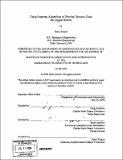Using learning algorithms to develop dynamic gaits for legged robots
Author(s)
Schaaf, Brian
DownloadFull printable version (12.24Mb)
Other Contributors
Massachusetts Institute of Technology. Dept. of Aeronautics and Astronautics.
Advisor
Greg Andrews and Brent Appleby.
Terms of use
Metadata
Show full item recordAbstract
As more legged robots have begun to be developed for their obvious advantages in overall maneuverability and mobility over rough terrain and difficult obstacles, their shortcomings over flat terrain have become more apparent. These robots plod along at extremely low speeds even when the ground is flat and level due to the fact that virtually all legged robots use a very stable, very slow walking gait to move, regardless of whether the ground is flat or rough. The simplest way of solving this problem is to use the same method as legged animals: simply change the gait from a walk to a faster more dynamic gait in order to increase the robot's speed. It would be extremely useful if legged robots were capable of moving across flat ground at high velocities while still retaining their ability to cross extremely rough or broken ground. Unfortunately, dynamic gaits are quite difficult to program by hand and only minimal research has been done on them. This thesis evaluates the use of two different types of learning algorithms (a genetic algorithm and a modified gradient-climbing reinforcement learning algorithm) as applied to the problem of developing dynamic gaits for a simulation of the Sony Aibo robot. (cont.) The two algorithms are tested using a random starting population and a high-fitness starting population and the results from both tests are compared. The research focuses on three different types of dynamic gaits: the trot, the canter, and the gallop. The efficiencies of the learned gaits are compared to each other in order to try to determine the best type of high-speed gait for use on the Aibo robot. Problems with the design of the Aibo robot as related to performing dynamic gaits are also identified and solutions are proposed.
Description
Thesis (S.M.)--Massachusetts Institute of Technology, Dept. of Aeronautics and Astronautics, 2006. Includes bibliographical references (p. 129-134).
Date issued
2006Department
Massachusetts Institute of Technology. Department of Aeronautics and AstronauticsPublisher
Massachusetts Institute of Technology
Keywords
Aeronautics and Astronautics.